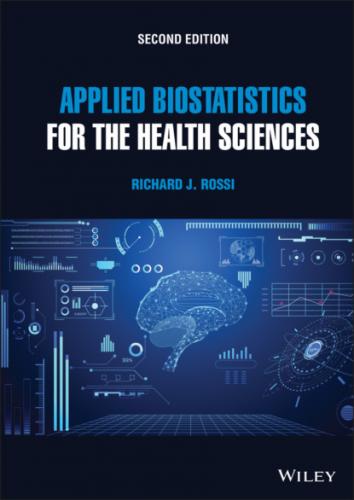Applied Biostatistics for the Health Sciences. Richard J. Rossi
Statistical Hypotheses. Chapter 7 includes a general discussion of hypothesis testing and significance testing that is followed by the hypothesis tests for testing hypotheses about a single proportion, t tests for a single mean, paired t-tests, and the two-sample t-test. Formulas for determining the approximate sample size required for a test having a prespecified size and power are also presented for each testing procedure.
Chapter 8: Simple Linear Regression. Chapter 8 is the first chapter in a series of chapters on modeling a response variable. The topics covered in Chapter 8 include analyzing scatterplots, correlation, the simple linear regression model, fitting and assessing the fit of a simple linear regression model, and statistical inferences drawn from a fitted model.
Chapter 9: Multiple Regression. Chapter 9 extends and broadens the methods discussed in Chapter 8 to multiple regression models. The multiple regression topics that are discussed in Chapter 9 include linear and nonlinear models, fitting and assessing the fit of a multiple regression model, drawing inferences from a fitted model, comparing nested regression models, dummy variable models, and variable selection procedures.
Chapter 10: Logistic Regression. Because building a logistic regression model is similar to building a linear regression model, the discussion of logistic regression follows immediately after the two chapters on linear regression. Topics discussed in Chapter 10 include the odds of an event, the odds ratio, logistic regression models, fitting and assessing the fit of a logistic regression model, drawing inferences from a logistic regression model, and variable selection.
Chapter 11: Design of Experiments. Chapter 11 provides an introduction to designing an experiment and precedes the typical chapter on analysis of variance. Topics covered in Chapter 11 include a discussion of experiments and observational studies, the completely randomized and randomized block designs, factorial experiments, and linear models for designed experiments.
Chapter 12: Analysis of Variance. Chapter 12 is the traditional chapter on analysis of variance. In Chapter 12, analysis of variance is discussed for single factor, randomized block, and factorial studies including discussions of the F-tests, the Bonferroni method of separating means, and methods for determining the number of replications needed for a study.
Chapter 13: Survival Analysis. Chapter 13 introduces methods for analyzing survival data. In particular, survival data, survivor functions, censoring, the Kaplan–Meier nonparametric estimator, the log-rank test, Cox’s proportional hazards semiparametric estimator, and logistic regression for survival data are discussed.
This book was intended neither to cover all of the methods used in the statistical analysis of biomedical and healthcare data nor to be used as cookbook with recipes for several different statistical analyses. The primary emphasis of this book is to introduce students to the basic ideas of biostatistics and modeling approaches used in biostatistics.
It is also my experience that the order of presentation is appropriate for the nurture and development of the student’s confidence and statistical maturity. I also believe that the statistical methods and ideas presented in Applied Biostatistics for the Health Sciences will provide a student with the necessary statistical tools required to succeed in advanced statistics courses such as linear or logistic regression, design and analysis of experimental data, multivariate statistics, analysis of microarray data, and survival analysis.
Special Features
The special features of this book include the following:
The importance of using/designing well-designed sampling plans is heavily emphasized throughout this text.
Concepts are emphasized over computational formulas throughout this text.
Several topics that are not usually covered in a first course in biostatistics are included in Applied Biostatistics for the Health Sciences, such as bootstrapping, sampling, sample size computations for two-sample confidence intervals and hypothesis tests, design of experiments, and survival analysis.
A large number of the examples are based on real-life studies published in biomedical and healthcare journals.
Bivariate data and bivariate analyses are presented early in the text. In particular, correlation, simple linear regression, and contingency tables are all introduced in Chapter 4.
Logistic regression follows immediately after a discussion of linear regression, which seems natural.
References are given to difficult problems that often occur when building and assessing a statistical model.
I have written this textbook with the expectation that access to a statistical computing package will be available to the students, and thus, the emphasis of this text is placed on the correct use, interpretation, and drawing statistical inferences from the output provided by a statistical computing package rather than the computational aspects required of the statistical methodology. While MINITAB® was used to produce the plots and computer output throughout the text, an introductory biostatistics course can be taught from Applied Biostatistics for the Health Sciences using any of the commonly used statistical computing packages, SAS, STATA, and SPSS or open source software such as R. The vast majority of the exercises do not depend on the particular statistical computing package being used, and in fact, many of the exercises do not require a statistical computing package at all. I have also created several Microsoft® Office Excel® worksheets for Applied Biostatistics for the Health Sciences that can be used for determining sample sizes, computing confidence intervals, and computing test statistics and p-values that are available on the book’s website.
Pedagogical Features
The key pedagogical features of Applied Biostatistics for the Health Sciences include the following:
The important formulas, procedures, and definitions are highlighted.
There is a glossary at the end of each chapter containing the key terminology and ideas introduced in the chapter.
Wherever possible the subscripts were dropped from the variables to simplify the notation used with many of the statistics.
There are numerous worked out examples illustrating important concepts and proper use of a statistical method.
Real-life data are used wherever possible in the examples and exercises, and the real-life data sets used throughout the book are available on the book’s website.
Computer output is provided in many of the examples and exercises to minimize the computational aspects of the statistical methods that have been used.
A
